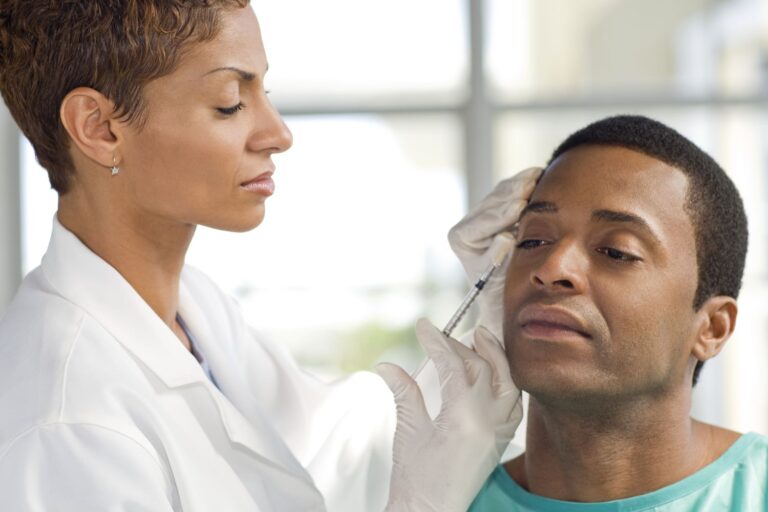A headache is likely to occur after Botox (onabotulinumtoxin A) injections into the facial muscles. Usually mild and brief, about 1% of these headaches are severe, debilitating and longer lasting. This side effect can occur just hours after treatment.
Headaches after Botox may come as a surprise, since chronic migraine prevention is one of the reasons for the treatment. Known for its cosmetic use in smoothing facial wrinkles, Botox is also used therapeutically to relieve conditions such as blepharospasm (eyelid spasm), spasticity (abnormal muscle contraction), and overactive bladder.
Botox contains very small amounts of a toxin derived from Clostridium botulinum bacterium. This botulinum toxin works by damaging nerve function. Since your nerves are responsible for sending signals to your muscles, when Botox is injected, the targeted muscle relaxes and becomes paralyzed.
This article will discuss headache as a side effect of Botox, including how it can be relieved and when you can expect it to resolve. Other possible side effects of Botox will also be briefly discussed.
Rick Gomez/Getty Images
Side effects
The side effects of Botox vary depending on the area of the body (eg forehead or bladder muscles) where the drug is injected.
For example, to prevent chronic migraine, Botox injections are divided into seven specific muscles of the head and neck. Neck pain and headache are the most commonly reported side effects for this indication.
Other side effects of Botox include:
- Dry mouth
- Discomfort/pain, swelling, redness, bleeding at the injection site
- Generalized feeling unwell, nausea and flu-like symptoms
- Fatigue
- Vision disturbances (eg double vision, blurred vision or reduced vision)
- Drooping eyelids or eyebrows
- Swelling of the eyelids
- Dry eyes
- Upper respiratory tract infection
- Urological problems (eg, discomfort, pain or burning when urinating, inability to empty the bladder or urinary tract infection or urinary tract infection)
- Allergic reaction (eg symptoms may include itching, hives, wheezing, dizziness or feeling faint)
Botox has a boxed warning, the most serious warning from the Food and Drug Administration (FDA). A potentially life-threatening side effect is if the toxin spreads far from where the drug is injected.
Botulism poisoning
Symptoms of botulinum toxin spread require immediate medical attention and may include:
- Problems breathing and/or swallowing
- Muscle weakness throughout your body
- Double vision, blurred vision and droopy eyelids
- Hoarseness or loss of voice
- Difficulty saying words clearly
- Loss of control of your bladder
Headache after botox
A headache can occur after Botox injections for a few different reasons. One is that when injected with Botox, the targeted muscle first breaks down before eventually relaxing and paralyzing. This muscle spasm can cause a headache.
A headache can also develop if a blood vessel is injured during the Botox injection and a hematoma (pool of blood) forms. This can cause a headache along with a tender, bruised bump on the skin.
Accidentally poking the needle into the skull bone or stress/anxiety about having Botox injections can also contribute to the headache.
The good news is that headaches associated with Botox injections seem to be mild and go away in one to three days after treatment.
There are very rare reports of Botox-related headaches being severe and/or persisting for weeks. In these unusual cases, experts suspect that the headache may have come from either a faulty technique or a “bad” batch of Botox—one containing some kind of impurity.
Treatment
Botox-related headaches can usually be relieved with an over-the-counter (OTC) pain reliever such as Tylenol (acetaminophen) or a nonsteroidal anti-inflammatory drug (NSAID) such as Motrin or Advil (ibuprofen).
These are the same drugs used to treat tension-type headaches—a dull, pressure-like pain felt around the entire head.
Since Tylenol and NSAIDs are not appropriate medications for some people, be sure to talk to your healthcare provider before taking them. For example, NSAIDs should be avoided in people with certain underlying health problems such as heart disease, kidney failure, or a history of stomach bleeding.
Keep in mind that some Botox providers may prefer that their patients avoid NSAIDs altogether. This is because NSAIDs can thin the blood and can cause or further worsen any bruising or blood vessel injury.
Call your Botox provider
If your headache is severe or persists despite treatment, call the health care provider who administered the Botox treatment.
Finally, if you’re constantly getting headaches after your injections, talk to your Botox provider. They may be able to inject a lower dose of Botox or change the injection site at your next visit to prevent a headache.
Summary
Botox is a versatile drug used to reduce facial wrinkles and folds, prevent chronic migraine headaches, and treat overactive muscles, among other conditions. Headache is a possible side effect that can occur with Botox injections in the head, neck or face.
Fortunately, this side effect is mild and can be alleviated with over-the-counter pain relievers. See your healthcare provider if you continue to feel uncomfortable.
A word from Verywell
With its versatile uses and strong safety profile, Botox is certainly an excellent drug. However, if you are considering Botox injections, be sure to seek out a healthcare provider who has training and plenty of experience in administering them.
Also, keep in mind that getting Botox often requires a commitment on your part. This is because the effect of Botox is temporary, lasting about three months. You may need repeated injections to maintain any desired cosmetic or therapeutic effect.



:max_bytes(150000):strip_icc()/Colleen-Doherty-MD-660-9d8d5f15b5a8408d91816814d441735b.jpg)